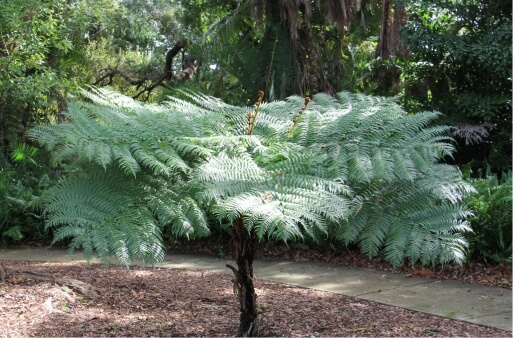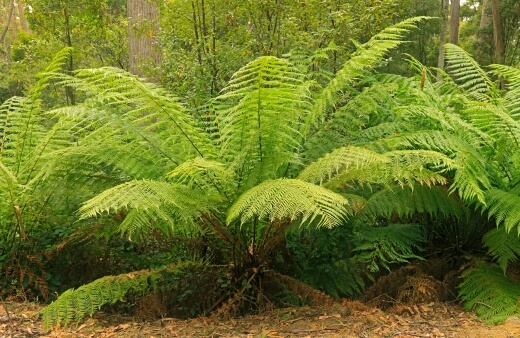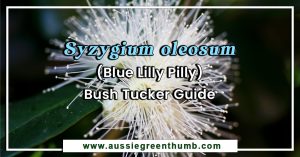Tree ferns are one of the most fascinating plants you can grow in Australia. With their ancient ancestry and tropical looks, they add a touch of exotic beauty to any garden, without needing to do much actual gardening at all.
As native plants, they are easy to grow, but look incredibly impressive when you do. Follow our expert tips to grow these stunning trees at home, as well as how to choose the right type for your garden.
More...

Genus: | Cyathea, Dicksonia, Alsophila |
|---|---|
Species: | Various |
Origin: | Australia, New Zealand, and Southeast Asia |
Common Names: | Tree fern |
Location: | Outdoor |
Type: | Fern, tree |
Growth: | Some species reach 20 m tall |
Sun requirements: | Partial to full shade |
Foliage Colour: | Various shades of green |
Flower Colour: | None |
Flowering: | None |
Edible Parts: | None |
Maintenance level: | High |
Poisonous for pets: | Non-toxic |
What is a Tree Fern?
Tree ferns are not true ferns. They actually belong to an order of plants called Cyatheales, characterised by their tall, slender trunks that are covered in a fibrous, hairy layer called the stipe.
The stipe is the old leaf base, which hardens into a protective layer for the trunk. The top of the trunk is crowned with a crown of large, frilly leaves called fronds, which give the tree fern its distinctive look, and make it particularly useful for creating attractive layers, dappled light, and adding shade to your garden.
Tree Fern’s Natural Habitat
Tree ferns are native to tropical and subtropical regions around the world, including Australia, New Zealand, and the Pacific Islands. They thrive in humid, shady environments and can be found growing in rainforests, swamps, and along stream banks. In their natural habitat, tree ferns can grow to be 4.5 to 9 metres tall.
How do Tree Ferns take water?
As well as drinking water through their roots, like most plants, tree ferns also take water in through the trunk. While you can grow tree ferns with just groundwater (basic drip irrigation often works in more humid parts of the country), it’s important to regularly spray the trunk with water.
Best Types of Tree Ferns to Grow in Australia

Dicksonia antarctica
The most commonly grown tree fern in Australia, Dicksonia antarctica, can grow up to 6 metres tall and 3 metres wide. It is native to eastern Australia and is best known for its soft, hairy trunk and large, frilly fronds.
Growing Dicksonia antarctica is easy no matter where you are in Australia, as it is nearly completely frost-hardy, and will get through winter outdoors with fleece or straw wrapped over the top of its trunk through the cold months.
Cyathea cooperi
Also known as the lacy tree fern, Cyathea cooperi is native to eastern Australia and grows to 4.5 metres tall. Its delicate, lacy fronds give it a light, airy appearance, and are ideal for planting around patios to provide dappled shade around a seating area.
Cyathea australis
The rough tree fern, Cyathea australis, is native to southeastern Australia and Tasmania and can grow up to 9 metres tall. This gigantic tree fern is slow-growing, but will eventually be the centrepiece of your garden, providing shade, texture, and structure to any space with its and has large, rough-textured fronds.
Cyathea dealbata
Cyathea dealbata, also known as the Silver Fern, is an iconic tree fern native to New Zealand. Renowned for its striking silver-white undersides of the fronds, Silver fern is a symbol of New Zealand's lush and diverse landscapes. With a robust trunk and a preference for shaded, moist environments, Cyathea dealbata adds a touch of elegance to gardens.
How to Grow Tree Ferns in Australia
Best Conditions for Planting Tree Ferns
When planting a tree fern, the key is well-drained but firm soil and filtered shade. The ideal soil for tree ferns is a mix of leaf mould, sand, and compost, which will allow the roots to anchor quickly, and add sufficient moisture retention while the roots take hold.
Dig a square hole that is about three times wider than the root ball and at the same depth. Gently place the root ball into the hole and backfill with soil.
Once the root ball is covered, tread around the base of the plant firmly to anchor it in, and drive treated timber stakes into the ground on three sides to provide support against high winds for the first few years (remove these after three years).

Soil & Drainage
Tree ferns prefer soil that is rich in organic matter like compost, or leaf mould. They also require good drainage to prevent waterlogging, which can lead to root rot. If the soil in your garden is heavy clay, add sand, perlite, or vermiculite to improve drainage.
Water Requirements
Tree ferns require regular watering to keep the soil moist, and in hot, dry weather, they may need to be watered every day to prevent the fronds from drying out. To prevent waterlogging, water the plant slowly and deeply, allowing the water to soak into the soil.
However, treat that advice with care, as they also hate being overwatered. That means setting a routine but adapting it, and not watering if the soil looks or feels damp.
Light and Shade
Tree ferns thrive in dappled or filtered shade. Full sun, as with true ferns, will burn their leaves to a crisp, creating very sad-looking plants that will live but never thrive.
For cooler regions, tree ferns will be fine out in the open, but in warmer parts of Australia, plant your tree fern either in the shade of other trees or in the afternoon shadow or the house.
Propagating Tree Ferns
Tree Ferns are propagated through spores (small, dust-like particles that come from the undersides of mature fronds). Propagating Tree Ferns can be challenging, but it's a fun one if you get it right.
- Collect spores: Collect mature fronds and place them in a paper bag. As the fronds dry out, they will release spores into the bag.
- Sow spores: Sow the spores on the surface of a soil mixture made up of equal parts compost and coarse sand. Keep the soil moist and warm by covering the pot with plastic wrap or a clear plastic bag to retain humidity.
- Wait for the spores to germinate: It can take 3 to 6 months for the spores to germinate, so keep the soil moist and the environment humid until they do.
- Transplant: Once the spores have germinated, and the seedlings have developed a few fronds, you can transplant them into individual pots until they’re big enough for their permanent position.
Caring for Tree Ferns
Tree Ferns are relatively low-maintenance plants, but they do require some care to keep them healthy.

Mulching Tree Ferns
Mulching will help to keep the soil around your Tree Ferns moist and cool. Use a good organic mulch like shredded bark or leaf mould. Spread a layer of mulch around the base of your Tree Ferns, being careful not to cover the crown of the plant.
Fertilising Tree Fern
Tree Ferns are not heavy feeders, but they do benefit from a light application of general-purpose fertiliser in spring and summer. This can be achieved by using compost or leaf mould as a mulch, rather than inert stone or bark mulches.
Commmon Tree Fern Pests and Diseases
Tree Ferns are pretty resistant to pests and diseases, but they can be susceptible to mealybugs and scale insects, which can both be controlled with insecticidal soap or neem oil.
Tree Fern diseases are rare but can occur, especially if the plant is stressed or not growing in optimal conditions. Diseases such as leaf spot and root rot are caused by overwatering or poor drainage so make sure to check on the soil condition once or twice a year, even if your plant looks healthy, and amend it if it’s looking overly damp, or overly dry.
Tree Fern Frequently Asked Questions

How often should I water my Tree Fern?
Water your Tree Fern regularly, but allow the soil to dry out slightly between waterings. For most Australian gardeners, that will mean a weekly water in spring, twice a week in summer, and once a month in autumn. Stop watering altogether in winter, cut the fronds back to allow dormancy, and promote fresh leaves in spring.
Do Tree Ferns need fertiliser?
Tree Ferns are not heavy feeders, but they do generally appreciate a rich organic mulch in spring. If you’ve forgotten to mulch, you can replace those nutrients with any general-purpose liquid feed in summer - but you’ll probably need to apply it once a month with water.
Do Tree Ferns require much pruning?
Tree Ferns don't require much pruning, but any damaged or diseased leaves should be cut out when you see them, and in winter, you can cut every single leaf right back to the crown. This isn't necessary in warmer parts of the country, but it will tidy up your plants, and encourage abundant fresh growth in spring.
Wrapping Up Our Guide to Growing Tree Ferns in Australia
Tree ferns are a stunning addition to any garden, and are surprisingly easy to grow. By following our expert tips, you can create the ideal growing conditions for your own spectacular tree ferns and enjoy them in your garden for years to come.
These ancient native plants will add a touch of drama and elegance to your garden, with very little input from you, especially once they’ve been properly established.
Published on May 7, 2023 by Maisie Blevins
Last Updated on January 28, 2024




